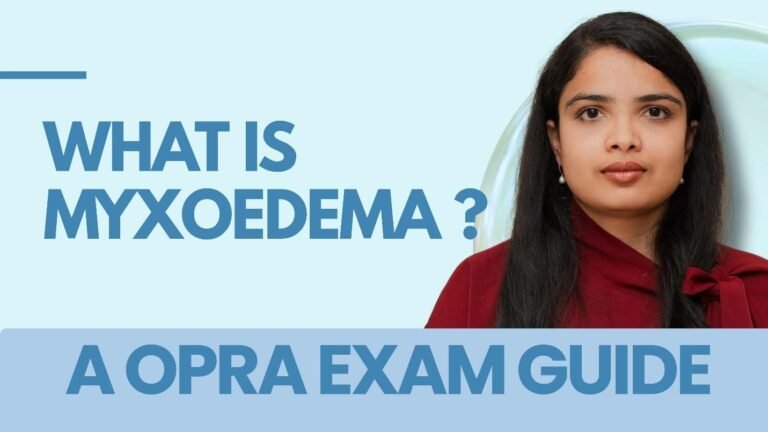When a hypothyroidism is untreated, a severe and advanced condition named Myxoedema is formed. It is a condition where the thyroid gland fails to produce enough thyroid hormones (T3 and T4). This under production of this crucial hormone will lead to a slow metabolism, and multiple organ dysfunctions and life-threatening complications like coma.
There are several topics pharmacists should consider while preparing for competitive exams like OPRA Exam. Myxoedema is an important topic that frequently appears in endocrinology, pharmacotherapy, and clinical case scenarios as part of exams. Having a clear idea about the pathophysiology, symptoms, and emergency management is crucial. It will not only help to pass the exam, but also will help to practice safe;y and effectively in future.
Key Concepts
- Untreated hypothyroidism can cause severe skin and tissue swelling, known as myxoedema.
- It is caused by the accumulation of mucopolysaccharides in the skin and soft tissues, causing swelling.
- Symptoms include confusion to unconsciousness, slow heart rate, hypothermia, and sometimes respiratory failure.
- It is commonly observed in middle-aged and older adults and is more prevalent in women.
- If this condition is not treated, it can cause a life-threatening condition known as myxoedema coma.
- Treatment involves thyroid hormone replacement, with intravenous levothyroxine.
Pathophysiology of Myxoedema
- It shows a significant Low Thyroid Hormone Levels in the blood (low level of T3 and T4)
- It results in a decreased oxygen consumption and heat production, causing cold intolerance and weight gain.
- In myxoedema, there is an accumulation of mucopolysaccharide which leads to water retention in the skin and subcutaneous tissues. This is a major characteristic of non-pitting edema.
- It leads to multi organ dysfunction including Cardiovascular, neurological, gastrointestinal, and dermatological systems are involved.
Non-pitting edema is a significant feature of myxoedema and helps to differentiate it from edema
Clinical features of Myxodema
| System affected | Symptoms |
| Skin & Hair | Dry, coarse skin, brittle hair, hair loss (especially lateral eyebrows) |
| Face | Puffy face, periorbital swelling, macroglossia |
| CVS | Bradycardia, pericardial effusion, low BP |
| GI | Constipation, bloating |
| CNS | Slow reflexes, lethargy, depression, memory impairment |
| Metabolic | Weight gain despite poor appetite, cold intolerance |
Diagnosis
- Elevated TSH levels
- Presence of Free T4- Low levels confirm the diagnosis.
- Positive in autoimmune hypothyroidism (Hashimoto’s) test-presence of Anti-TPO antibodies
Treatment & Management
1. Lifelong Thyroid Hormone Replacement
- Levothyroxine (T4) -lifelong therapy
- Start with a low dose in elderly or cardiac patients and titrate every 6–8 weeks until TSH stabilizes.
2. Management of Myxoedema Coma (Medical Emergency)
| Step | Description |
| Emergency Care | ICU admission with cardiac monitoring, oxygen therapy, and mechanical ventilation if needed. |
| Thyroid Hormone Therapy | IV levothyroxine (LT4) as first-line; liothyronine (LT3) may be added for faster restoration of hormone levels |
| Glucocorticoids | IV hydrocortisone (or equivalent) to prevent adrenal crisis until adrenal insufficiency is ruled out |
| Supportive Measures | Treat precipitating factors (infection, trauma, cold exposure), maintain fluid balance, and prepare for difficult airway if necessary. |
3. Regular Monitoring should be done with TSH every 6–8 weeks until stable, then every 6–12 months.
Pharmacist’s Role: Educate patients about the importance of taking levothyroxine on an empty stomach, adhering to follow-up visits, and recognizing symptoms of over- or under-treatment.
Conclusion
Myxoedema is a serious but preventable condition that represents advanced hypothyroidism. Its hallmark feature, non-pitting edema, and classic laboratory findings (high TSH, low T4) make it an important condition to diagnose early. For OPRA aspirants, mastering this topic including emergency management of myxoedema coma is crucial.
At Elite Expertise, we cover rare but high-yield clinical topics like myxoedema with a case-based teaching approach, led by our expert faculty, Mr. Arief Mohammad and Mrs. Harika Bheemavarpu. Their real-life clinical experience ensures you understand not only the theory but also its practical application, preparing you for both your exams and professional practice as a pharmacist in Australia.
